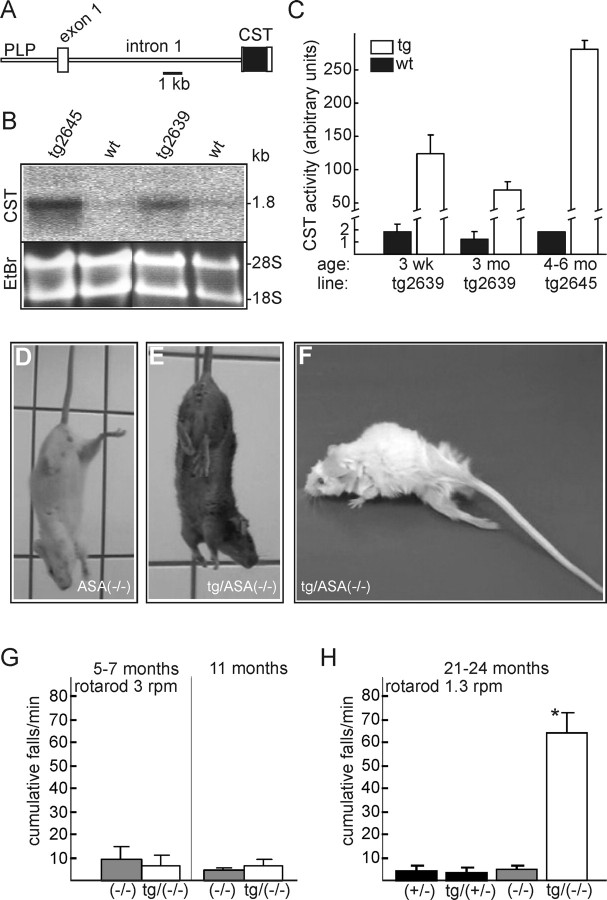Figure 2.
Generation of PLP-Gal3st1 transgenic mice. A, Schematic representation of the transgenic construct. B, Northern blot analysis of tg mice of lines tg2639 and tg2645 and non-tg wild-type littermates (wt) at 3 months of age. Equal loading was confirmed by ethidium bromide staining (EtBr). Both, transgene and endogenous Gal3st1 mRNA had a size of 1.8 kb (expression levels: tg2645>tg2639≫wt). C, Gal3st1 activity (mean + SD) in brain homogenates of 3-week-old (tg2639, n = 3), adult tg (tg2639, 3 months, n = 3; tg2645, 4–6 months, n = 2) and wt (3 weeks and 3 months, n = 3; 4–6 months, n = 2) mice. Gal3st1 activity was increased 60- and 200-fold, respectively, in tg mice of the lines tg2639 and tg2645 compared with wt controls. D, E, In a tail suspension test, non-tg ASA(−/−) mice (D) spread their hindlimbs, whereas tg/ASA(−/−) mice (E) often grasp the hindlimbs to their body. F, tg/ASA(−/−) mice develop a progressive hindlimb paralysis. G, H, Motor coordination deficits in tg ASA(−/−) mice were measured using a rotarod at 3 rpm (G) and 1.3 rpm (H) as described in Materials and Methods. G, ASA(−/−) and tg/ASA(−/−) mice at 5–7 and 11 months of age (n = 4) were tested on the rotating rod (3 rpm) for 1 min. The number of cumulative falls (mean + SD) was determined. There was no significant difference between ASA(−/−) and tg/ASA(−/−) mice. H, Mice of the following genotypes were tested at 21–24 months of age: ASA(+/−) [age (mean ± SD), 22 ± 1 months; n = 6], tg/ASA(+/−) (line tg2639; 22 ± 1 months; n = 10), ASA(−/−) (23 ± 1 months; n = 6), and tg/ASA(−/−) mice (line tg2639; 22 ± 1 months; n = 7). Rotarod speed was reduced to 1.3 rpm. At this age, the difference between tg/ASA(−/−) and ASA(−/−) was statistically significant (t test, *p < 0.05). Similar results were obtained for tg mice of both lines, and therefore data were combined at 5–11 months of age. CST, Mouse Gal3st1 cDNA.

